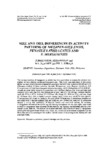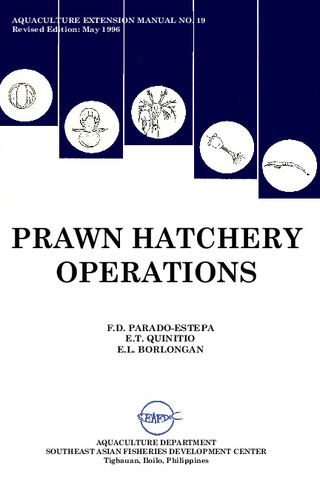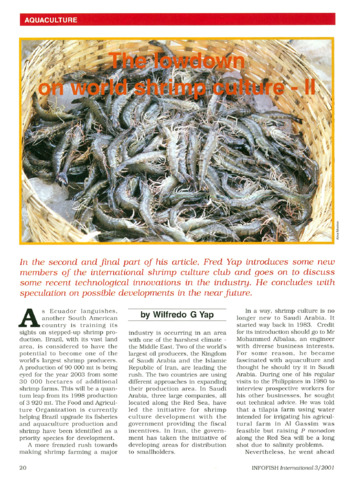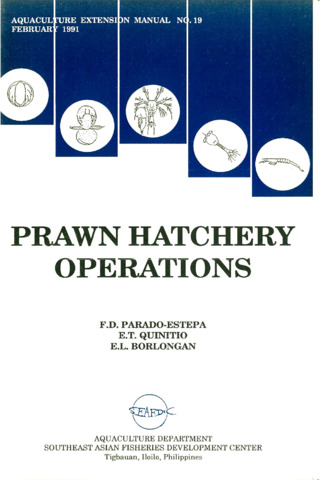Size and diel differences in activity patterns of Metapenaeus ensis, Penaeus latisulcatus and P. merguiensis

View/
Request this document
Date
2000Page views
501Metadata
Show full item recordCited times in Scopus
Share
Abstract
The nursery function of mangroves as shelter has been postulated to explain the positive correlation between shrimp catches and mangrove area. This study was undertaken to document shelter use and other activities in mangrove‐associated penaeids and to determine diel and size differences relating to these activities. Juvenile Metapenaeus ensis, Penaeus latisulcatus and P. merguiensis collected from mangrove areas in Guimaras, central Philippines and stocked individually in glass tanks (= replicates) provided with artificial shelters and sand substrate were observed every hour for 25 h. Size classes tested were very small (1–5.9 mm carapace length); small (6–10.9mm CL); medium (11–15.9mm CL); large (16–20.9mm CL); and very large (21–25.9 mm CL). Due to limited juvenile supply, only 3 sizes were tested for each species: P. merguiensis (very small to medium), M. ensis (small to large) and P. latisulcatus (medium to very large) with 5 replicate animals (one per tank) per size. Juvenile M. ensis and P. latisulcatus showed a strong diel periodicity of daytime burial and nocturnal activity. In contrast, P. merguiensis showed active swimming and feeding throughout the day and night. Very small to small P. merguiensis were observed on the shelters, but burying was exhibited only by a few medium‐sized juveniles. This shelter use is consistent with observations of small P. merguiensis entering the mangrove forest (where roots, twigs, etc. contribute to structural complexity) on the flood tide and concentrating in the shallow, turbid waters of adjoining creeks during ebb tide and slack water.
Suggested Citation
Primavera, J., & Lebata, M. J. H. L. (2000). Size and diel differences in activity patterns of Metapenaeus ensis, Penaeus latisulcatus and P. merguiensis. Marine and Freshwater Behaviour and Physiology , 33(3), 173-185. https://doi.org/10.1080/10236240009387089
Subject
activity patterns; marine crustaceans  ; commercial species
; commercial species  ; cultured organisms; diurnal variations; feeding behaviour
; cultured organisms; diurnal variations; feeding behaviour  ; fisheries
; fisheries  ; juveniles
; juveniles  ; mangrove swamps
; mangrove swamps  ; nursery grounds
; nursery grounds  ; ontogeny
; ontogeny  ; shrimp fisheries
; shrimp fisheries  ; size distribution
; size distribution  ; swimming
; swimming  ; mangroves
; mangroves  ; substrata
; substrata  ; Penaeus latisulcatus
; Penaeus latisulcatus  ; Penaeid shrimps; Metapenaeus ensis
; Penaeid shrimps; Metapenaeus ensis  ; Penaeus merguiensis
; Penaeus merguiensis  ; Philippines
; Philippines  ; Banana prawn; Greasyback shrimp; Western king prawn
; Banana prawn; Greasyback shrimp; Western king prawn
 ; commercial species
; commercial species  ; cultured organisms; diurnal variations; feeding behaviour
; cultured organisms; diurnal variations; feeding behaviour  ; fisheries
; fisheries  ; juveniles
; juveniles  ; mangrove swamps
; mangrove swamps  ; nursery grounds
; nursery grounds  ; ontogeny
; ontogeny  ; shrimp fisheries
; shrimp fisheries  ; size distribution
; size distribution  ; swimming
; swimming  ; mangroves
; mangroves  ; substrata
; substrata  ; Penaeus latisulcatus
; Penaeus latisulcatus  ; Penaeid shrimps; Metapenaeus ensis
; Penaeid shrimps; Metapenaeus ensis  ; Penaeus merguiensis
; Penaeus merguiensis  ; Philippines
; Philippines  ; Banana prawn; Greasyback shrimp; Western king prawn
; Banana prawn; Greasyback shrimp; Western king prawn
Collections
- AQD Journal Articles [1240]
Related items
Showing items related by title, author, creator and subject.
-
Prawn hatchery operations
Parado-Estepa, Fe D.; Quinitio, Emilia T.; Borlongan, Emeterio L. (Aquaculture Department, Southeast Asian Fisheries Development Center, 1996-05)The manual, an updated version of the 1984 SEAFDEC/AQD manual, presents the underlying principles and step-by-step instructions of prawn larval and post-larval rearing. The techniques described are not only applicable to ... -
The lowdown on world shrimp culture - II
Yap, Wilfredo G. (INFOFISH, 2001)This paper introduces some new members of the international shrimp culture club and goes on to discuss some recent technological innovations in the industry, particularly the polyculture of tilapia (mainly Oreochromis ... -
Prawn hatchery operations
Parado-Estepa, Fe D.; Quinitio, Emilia T.; Borlongan, Emeterio L. (Aquaculture Department, Southeast Asian Fisheries Development Center, 1991-02)The manual, an updated version of the 1984 SEAFDEC/AQD manual, presents the underlying principles and step-by-step instructions of prawn larval and post-larval rearing. The techniques described are not only applicable to ...



